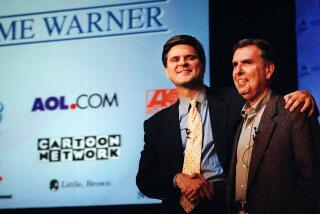Column: Making failure pay: Marissa Mayer could get $55-million severance for not turning Yahoo around
Yahoo as we know it is soon to be no more. Its “core assets”— the information websites and email service that most people have come to think of as Yahoo— will be sold to Verizon for $4.8 billion, about a tenth of the price Microsoft offered for the entire company in 2008. What’s left will be a holding company for Yahoo’s shares in two Asian high-flyers, Yahoo Japan and the Chinese ecommerce firm Alibaba.
And what of Marissa Mayer, the former Google executive recruited in June 2012 to turn Yahoo around? She’s in line to collect approximately $55 million in severance if she leaves because of the change in control, according to a company disclosure.
I love Yahoo, and I believe in all of you. It’s important to me to see Yahoo into its next chapter.
— Yahoo CEO Marissa Mayer
Mayer said Monday, after the Verizon deal was announced, that she’s planning to stay on. But that falls into the category of something she has to say, for now. The transition to Verizon ownership will last until early next year, and someone has to pilot the ship in the meantime.
“I love Yahoo, and I believe in all of you,” her statement reads. “It’s important to me to see Yahoo into its next chapter.” After that chapter opens, is she really going to stick around as a junior minister in Verizon? Not likely.
Mayer said “this is a a good moment to reflect on Yahoo’s journey to date.” It’s a better moment to reflect on Mayer’s record as CEO. Good for her that her personal payoff is lush.
We should stipulate first that turning around Yahoo would have been a herculean task for any incoming CEO. As we wrote in December, “Yahoo has been faltering for most of this century.” The firm dominated the Internet before and during the dot-com boom, reaching its all-time high price (a split-adjusted $118.75) on Jan. 3, 2000. Then it crashed with the rest of the dot-com economy, falling to $4.06 on Sept. 26, 2001. Its closing price Monday was $38.32.
The company’s real problems began with its appointment of Hollywood entertainment executive Terry Semel as CEO in 2001. Semel couldn’t handle the changes in Internet technology and usage that erupted around that time, including the rise in social media. He did try, however, offering $1 billion for a fledgling search company called Google. He was turned down by its founders, Sergey Brin and Larry Page.
Semel left Yahoo in 2007, to be followed by four CEOs in five years, including Mayer. At first her glamour and buzzy dynamism gave the company a jolt, but it wasn’t long before investors and others noticed that her growth strategy was as nebulous as her predecessors’. She had a habit of micromanaging the least important parts of the business; the year after her arrival, she got personally involved in redesigning Yahoo’s iconic logo, the very definition of a waste of a CEO’s time. Did anyone actually think that Yahoo’s problem was that its logo was outdated?
Mayer then went on a buying spree, acquiring 53 Internet businesses for a total of more than $2 billion. This was her so-called MaVeNS strategy, an acronym for “mobile, video, native advertising, and social.” She recognized, accurately, that Yahoo’s business model was to plaster advertising on everything it touched. But her acquisitions were haphazard, and generally mishandled.
There were apps for chat, travel recommendations, newsreading, conference calling, social media analysis, mobile marketing, etc., etc., etc. They all seemed to have names and products that wouldn’t be out of place in HBO’s satire “Silicon Valley”: Aviate, Flurry, HitPost, Tomfoolery. Most were shut down or otherwise disappeared into the Yahoo ether. A few are still around, notably the social media site Tumblr, acquired for $1 billion in 2013. It was telling that in announcing the deal, Yahoo said, “We promise not to screw it up.” That’s what a joke sounds like when it isn’t funny.
Yahoo kept claiming that the MaVeNS business was a genuine growth story. In revenue, perhaps, but the acquisitions didn’t seem to add anything to the bottom line. Tumblr turned out to be emblematic of the problem: Yahoo wrote down its value by $230 million in 2015, an admission that it had overpaid by at least that much for a company with little revenue. That was part of an enormous goodwill impairment charge of $4.5 billion the company took in 2015, an acknowledgment that it had overpaid for virtually the whole MaVeNS portfolio. The writedown contributed to an overall 2015 loss of nearly $4.4 billion on revenue of about $5 billion.
Yahoo’s best year recently was 2014, when it reported $7.5 billion in profits on revenue of $15 billion. But that only underscored its weakness, for $10.3 billion of that revenue and all of the gain stemmed from its sale of Alibaba American depository shares as part of Alibaba’s initial public offering that September.
In its way, Alibaba became Yahoo’s albatross. Its stake in the Chinese company was the product of a prescient $1-billion investment by Yahoo co-founder Jerry Yang. But the stake’s value had grown to the point it overwhelmed everything else about Yahoo, which began to be seen as merely a proxy for Alibaba. Managing the holding began to seem Job One for Yahoo management, while the value of the rest of the company withered away.
On May 2, 2016, the date used for share valuations in the company’s 2016 proxy statement, Yahoo valued its Alibaba stake at $29.4 billon and its 35.5% stake in Yahoo Japan (another pre-Mayer arrangement) at $8.7 billion. Yahoo’s market capitalization that day was $34.7 billion. In other words, the stock market valued everything other than those two holdings — that is, everything subject to Mayer’s management — at negative $3.4 billion.
Yahoo’s proxy says its management spent an enormous amount of time trying to figure out how to “maximize the value of our Alibaba stake” for shareholders; what that means is it searched for a way to spin off the shares tax-free. The company announced a plan to do so in January 2015, but dropped it almost a year later after the IRS signaled that it might not go along.
See the most-read stories in Business this hour >>
Every day wasted on this sort of financial engineering meant a day lost to the task of operating the company and turning it back into a player. The Verizon sale is an acknowledgment that the effort has failed. Yahoo will be folded into AOL, another Internet-age relic acquired by Verizon, potentially hastening the transformation of what was once a wide-open web into an agglomeration of walled gardens owned by telecommunications giants.
What’s left as the smoke clears from the Mayer regime is what she actually got paid for. Nominally, she received more than $100 million in compensation from 2013 through 2015, according to Yahoo disclosures. The company says, however, that Mayer took a steep haircut from her reported pay in the last two years because of Yahoo’s underperformance — a 40% cut in 2014 and a cut of more than 60% last year. That still left her with a $25-million paycheck in 2014 and $14 million last year. Plus $55 million, possibly more, in severance.
It would be unjust to say that Marissa Mayer ran Yahoo into the ground; the company was on the glide path to extinction when she took over. But she could not arrest the slide. It’s probably fair to say that she worked her fingers to the bone in the effort. But the end result effectively was the vanishing of Yahoo from the face of the Earth. Was she worth the money? Only in a world where failure is measured in eight figures.
Keep up to date with Michael Hiltzik. Follow @hiltzikm on Twitter, see his Facebook page, or email [email protected].
Return to Michael Hiltzik’s blog.
MORE FROM BUSINESS
Macy’s tests artificial intelligence as a way to improve sales
Why have upscale retailer Nordstrom and other apparel giants lost their luster?
Limited success of Chinese tire tariffs shows why Donald Trump’s trade prescription may not work
More to Read
Inside the business of entertainment
The Wide Shot brings you news, analysis and insights on everything from streaming wars to production — and what it all means for the future.
You may occasionally receive promotional content from the Los Angeles Times.










